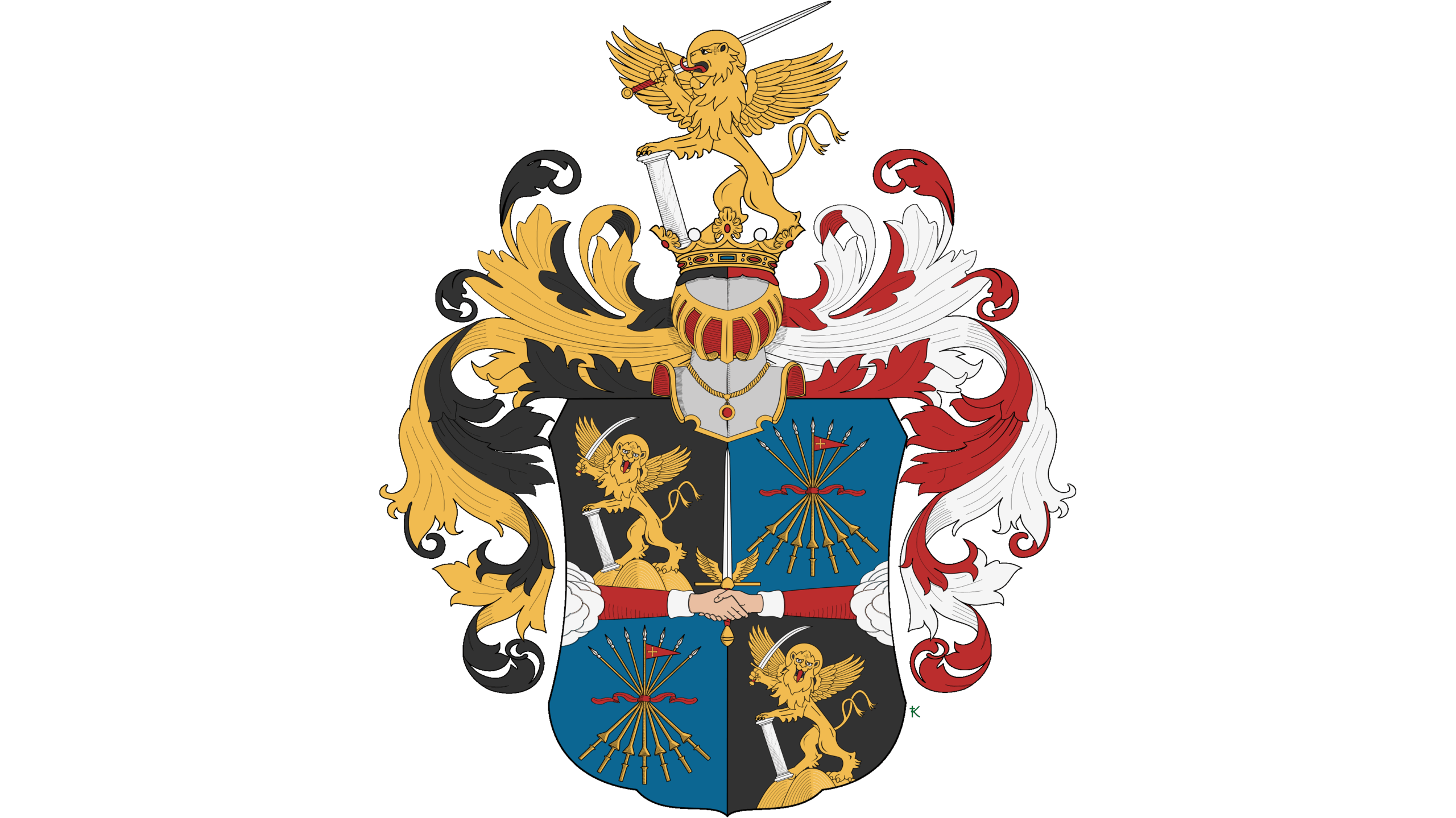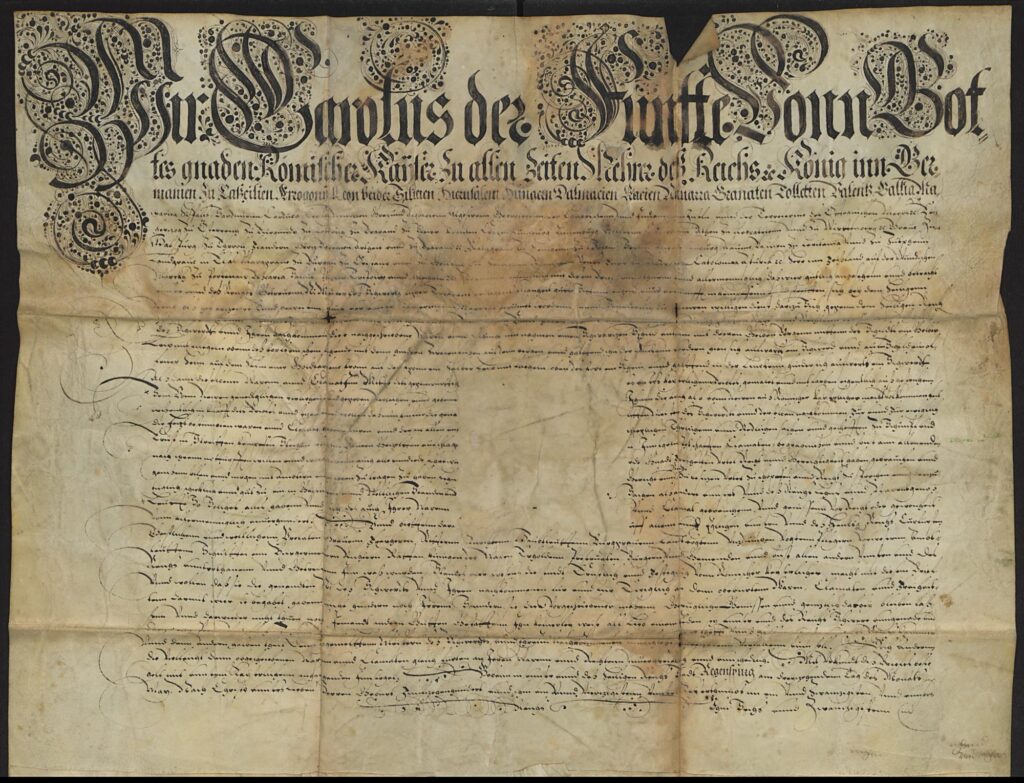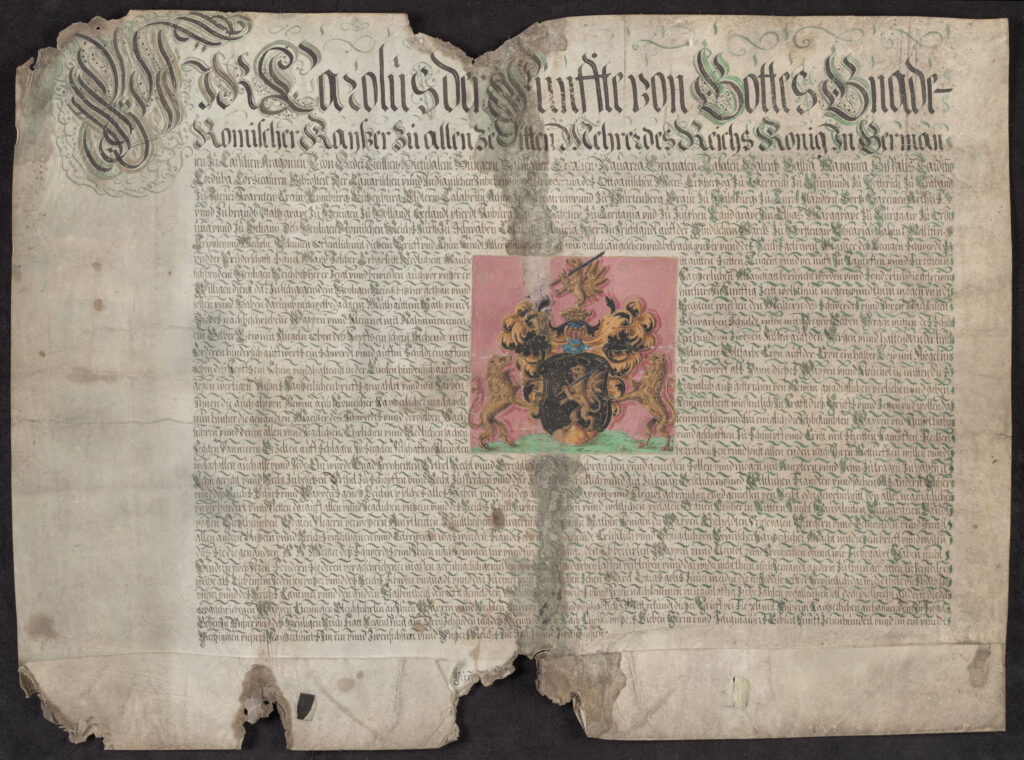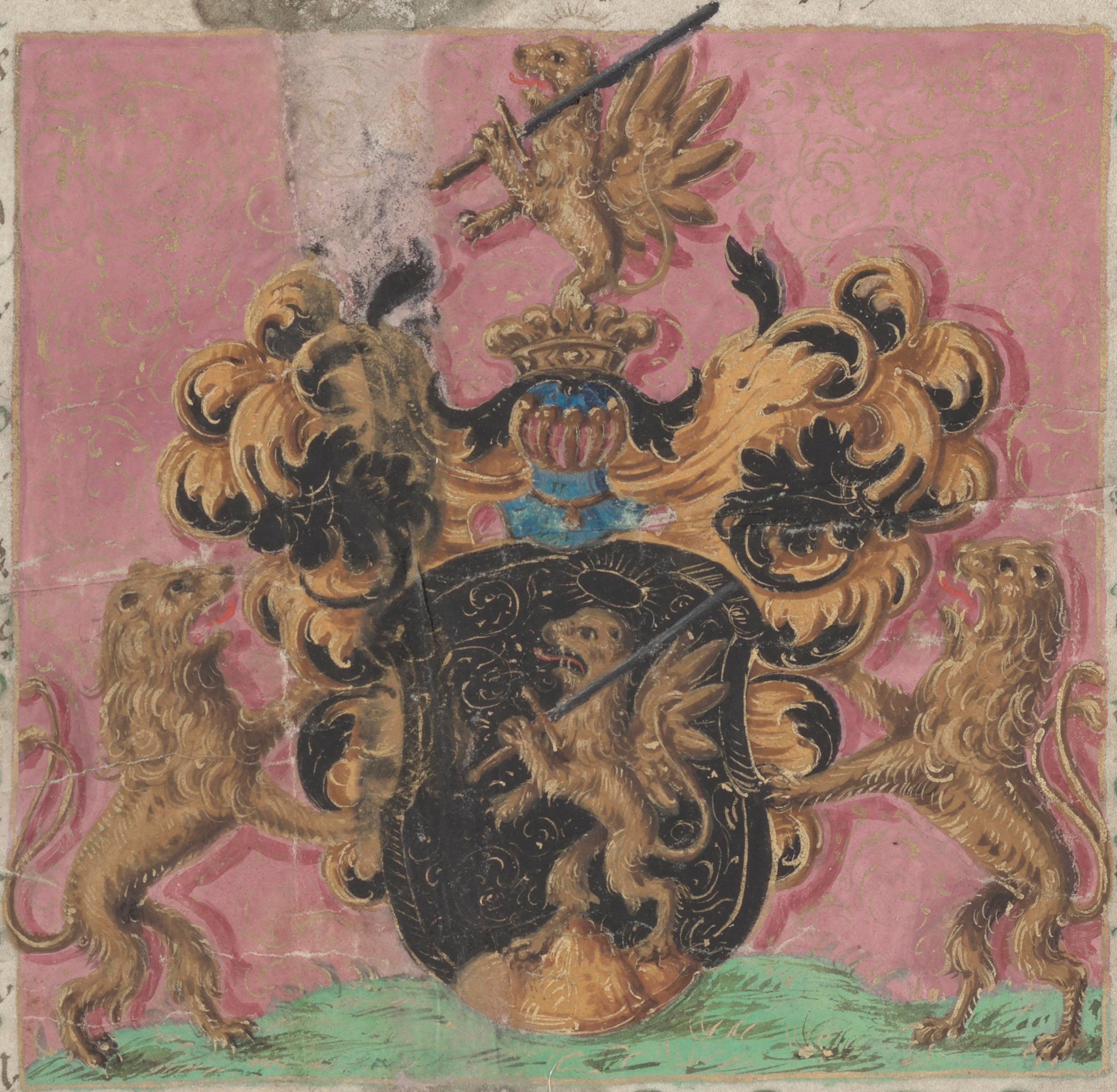This article is also available in German.
Frankfurt’s Masters of the Sword and Their Lost Emblem 🛡️ Part II
In 1541, Emperor Charles V granted the Frankfurt fencing guild of the Marxbrüder a coat of arms – their badge of Imperial recognition. If you haven’t read it yet, I warmly invite you to start with my last article on its rediscovery, as it sets the stage for the below.

The story of the Marxbrüder coat of arms does not end here: More than a century later, in 1670, Emperor Leopold I bestowed an augmentation of honor – a visual enhancement of the arms reflecting both heightened imperial favor and the heraldic style of the Baroque. Today, we encounter the Marxbrüder arms exclusively in the form of monochrome copies of this 1670 augmentation (for example, on Wikipedia). Yet, these reproductions leave much to be desired: The overall fidelity is low, individual elements blur, and – most importantly – the tinctures (i.e., the colors) are entirely missing.

To address this, I present a colored reconstruction of these augmented arms with unprecedented fidelity. It is based on a rediscovered concept of the augmentation charter – preserving both a detailed blazon and a colored depiction – and corroborating evidence. The resulting vector graphic is freely available under CC BY-SA 4.0, ensuring anyone may reuse or adapt it with proper credit.
Decoding the Augmentation: Heraldic Methodology
Before turning to the reconstruction, let’s clarify what an augmentation of arms is. When a bearer of arms distinguished themselves and rose further in imperial favor, the Emperor could grant an augmentation of honor – enhancing the arms by partitioning the shield, adding charges, or enriching the crest.
As we shall see, this 1670 augmentation by Leopold I went remarkably far: the comparatively simple arms of 1541 were transformed into an opulent composition, reflecting both the high favor the Marxbrüder must have enjoyed and the heraldic fashion of the Baroque.
Although the charter proclaiming this augmentation remains lost, a rediscovered concept and multiple independent sources provide a robust basis for reconstructing the augmented Marxbrüder arms in full tincture. The below diagram illustrates the process:
The two monochrome copies of the 1670 augmentation (A) serve as the starting point. These contain heraldic hatchings – established line and dot patterns that encode most of the tincture. The rest can be inferred from the earlier 1541 arms I had found in Basel (B), and the personal arms of a Marxbruder (C). I validate the reconstruction thus obtained (D) by comparing it with an Aulic Council concept of the 1670 augmented arms I received from the Haus-, Hof, und Staatsarchiv (HHStA) Vienna. This concept preserves not only a detailed blazon but also a colored depiction of the arms.
Why not simply take this colored depiction from the concept as the final result?
Because that would be less reliable. The concept represents a relatively final suggestion prepared before the official issuance of the augmentation, whereas the monochrome copies were most likely produced afterward and based on the original. By considering both together, we can interpolate with high confidence what the augmented arms must have looked like. For example, if both the concept and the monochrome copies agree on a tincture, it is highly unlikely that the arms diverged from both.
In other words, the concept with its colored depiction cannot stand alone as the final word. Only by weighing it against the monochrome copies, the 1541 charter, and comparative evidence can we move from a single preliminary trace to a historically robust reconstruction – yielding a reliable image of how the augmented Marxbrüder arms of 1670 most likely appeared.
From Hatchings to Hue: Reconstructing Tinctures
Before the actual image analysis, it’s worth taking a look at the origin of the monochrome copies: Copy 2 remains enigmatic, but copy 1 can now be clearly identified. It appears in a print of Marxbruder Martin Kaehl, first pointed out to me by Werner Ueberschär of Schwertbund Nürnberg – and later recalled by Kevin Maurer.
Martin Kaehl, a “Kuechen- und Loss-Beckh” (baker and confectioner) came from “Zilch aus der Marck” – most likely the former Züllichau in the Mark Brandenburg, today Sulechów in western Poland. As chief captain of the Marxbrüder, he not only held the guild’s highest office, but also had the authority to appoint sworn masters who passed their examination as masters of the sword. Of particular importance for us: Beneath his solemn portrait, he proudly displays the augmented Marxbrüder arms of 1670.
This suggests that the copy – despite its low fidelity and missing color – can serve as a dependable source for reconstructing the 1670 augmentation. Let’s take a closer look at what we see here:
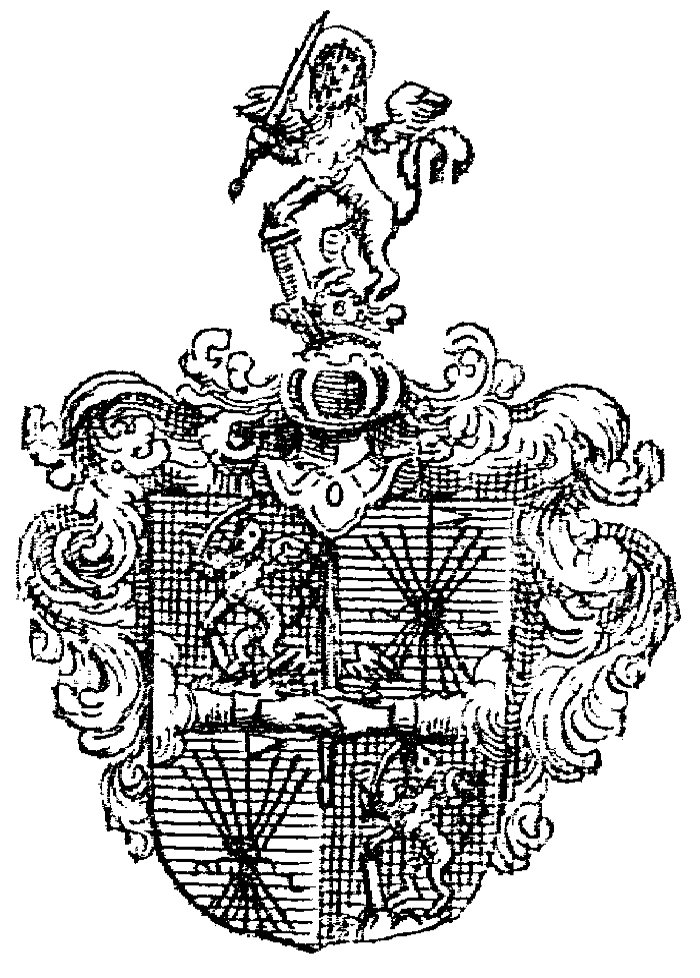
Now, placing this beside the second known copy of the augmentation, which we briefly encountered in the introduction, we find that – stylistic choices aside – they match in nearly every respect. We’ll turn to the minor differences in a bit.

Although the low fidelity may obscure some details, you can still likely recognize the hatchings across the quartered shield, the mantling in copy 1, and the arms in copy 2. These line patterns encode tincture; the relevant ones for us are:
So, field 1 and 4 are Sable, and field 2 and 3 are Azure. Also, one color of the mantling is Sable (copy 1), and the sleeves of the arms in the center are Gules (copy 2).
The fact that the second copy so closely mirrors the first one – while even adding further detail later confirmed as accurate – suggests that it either derives from the original arms as well, or from a high-quality intermediate copy unknown to us. In either case, it appears to be a legitimate source for reconstructing the 1670 augmentation.
To reconstruct the missing tinctures, we can apply the heraldic rule of tincture. It commands: 👉 Do not place a metal on a metal, or a color on a color.
Metals refer to the lighter tinctures – Or (gold/yellow) and Argent (silver/white) – while colors denote the darker ones, such as Sable (black), Azure (blue), and Gules (red). Though not an absolute law, this rule serves as a strong guideline to ensure visual clarity, offering a high degree of confidence when inferring uncertain tinctures.
Based on this, we can reasonably deduce that both the lion in field 1 and 4 and the lances in field 2 and 3 are either Or (gold) or Argent (silver). In fact, the original arms of 1541 (Staatsarchiv BS PA 101 1) confirm that the lion of St. Mark, appearing both on the shield and the crest, is Or (see last article). Similarly, the mantling, assuming it remained unchanged during augmentation, should be Sable doubled Or, aligning with the hatching that indicates partial Sable.
Taken together, this already gives us a nearly complete picture of the tincture. Below, I overlay the tincture as currently established, supplemented by further plausible assumptions that I will elaborate on next.
To summarize what we see:
- Quarterly; above the fess (horizontal) line, issuing from clouds on either side two arms vested Gules, clasping hands in handshake, together holding upright a winged sword.
- 1st and 4th quarters: Sable, upon a trimount Or, a Lion of St. Mark rampant (rearing upright) Or, fork-tailed, guardant (facing us), holding in his dexter paw a saber in copy 1 or a long sword in copy 2, and resting his sinister paw upon a scroll or pillar.
- 2nd and 3rd quarters: Azure, a sheaf of seven lances Or held together by a band, the central lance bearing a pennon. The callout states this tincture is inferred, and I’ll explain more on how.
- Upon the shield an open helmet, adorned with a crown of rank Or. At this point, we assume the mantling to be Sable doubled Or.
- Crest: a Lion of St. Mark rampant Or, fork-tailed, guardant (facing us) in copy 1, holding in his dexter paw a long sword, uplifted in copy 1 and shouldered in copy 2, and resting his sinister paw upon a scroll or pillar.
We infer the tincture of the remaining details based on default conventions:
- The hands are depicted in Carnation (light skin color), and the winged sword held by them should have a hilt Or and a blade Argent. For the sword’s wings, I went with an angelic Argent, although Or is also plausible.
- The clouds from which the arms emerge should be Argent, resembling their natural color.
- The scroll or pillar on which the St. Mark Lions rest their left paw should also be Argent, resembling parchment or light stone.
Inferring Lance Tincture from an Imperial Bodyguard’s Arms
Why are the lances dominantly Or?
Based on the rule of tincture, there are two options: Argent and Or. The personal arms of Imperial bodyguard Onoferus Sokh reveal that it should be the latter.
A bit of context: Masters of the Longsword had the right to bear the Marxbrüder arms, usually in slightly derived form: The shield would be partitioned per fess (i.e., divided horizontally), with the upper part and crest showing the Lion of St. Mark and the lower part the personal arms of a Marxbruder.
I may write more on the several surviving examples in the future, but will now focus on the best preserved one, including known tincture: Onoferus Sokh’s arms as displayed at the wedding of Archduke Charles II. of Austria 1571. I was made aware of this by the excellent prior work of Jens-Peter Kleinau.
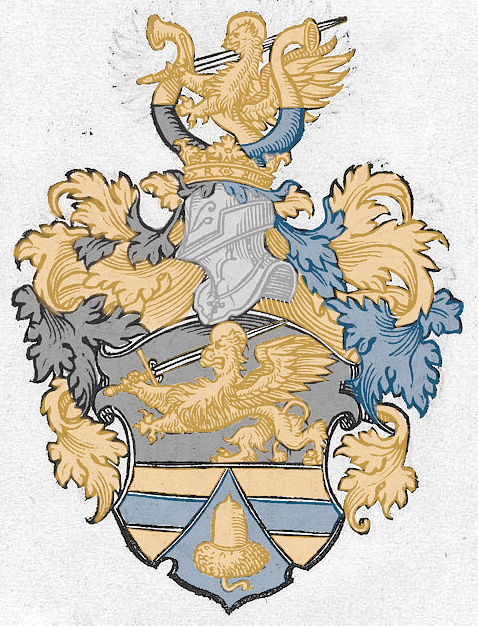
While the upper part with St. Mark’s lion is in the known tincture (Sable, a lion Or), the lower half features Or, a bar Azure. Upon this appears a wedge Azure, with an acorn Or.
Therefore, next to Sable and Or, Azure and Or were dominant Marxbrüder tinctures. This corresponds to the hatchings of the monochrome copies, in which fields 2 and 3 appear in Azure with initially unknown metal. Taken together, this strongly indicates that the prevailing metal for the lances in the Azure fields is Or. Following my naturalistic approach, I depicted the lanceheads in Argent. I likewise chose Argent for the band and pennon to better distinguish them.
A Colored Trace in the Archival Maze: Independent Validation via a Rediscovered 1670 Concept
Just as I had completed this reconstructive work, I received exciting news from Haus-, Hof, und Staatsarchiv (HHStA) Vienna.
I had sent an inquiry if any traces of the 1670 armorial augmentation by Leopold I remained. My hopes were low, as this time, I couldn’t even find a signature in the archive information system. However, my work on the Imperial privileges had deepened my understanding of the bureaucratic machinery of the court: Every privilege had to pass through the Aulic Council, one of the two supreme courts of the Holy Roman Empire, dealing with gratialia, or acts of grace. While the original grant charter was sent to the recipient – in this case, the Marxbrüder in Frankfurt – the Aulic Council would at least retain a regest: an abstract of the document’s contents, used for administrative recordkeeping and archival indexing.
In this case, I was extremely fortunate: a generous archivist at the HHStA confirmed that the Aulic Council had even preserved a concept of the charter – complete with both a blazon and colored depiction of the augmentation granted by Leopold I on 20 March 1670. Remarkably, this record has been stored in Vienna for over 350 years, where it still resides in a strikingly good condition. Although I had no signature to guide me, the archivist’s insight and responsiveness led me directly to the arms, nestled within a rich convolute of newly uncovered Marxbrüder records.
This discovery provides decisive evidence, enabling me to verify my reconstruction and to resolve uncertainties regarding tincture. The document can be found in a convolute of Marxbrüder charters located in the HHStA Vienna under signature RHR Grat Feud Conf. 48-3-1.
👉 To my knowledge, this convolute is the most comprehensive collection of Marxbrüder documents outside the Frankfurt holdings (ISG FFM, H.18.02 and ISG FFM, H.18.03).
The HHStA also houses a similar convolute for the rival Federfechter guild in Prague (RHR Grat Feud Conf. 48-4-1), and a third one for an enigmatic “Faber” fencing society (RHR Grat Feud Conf. 48), dating back to 1365. If this was indeed a separate guild with comparable privileges, it would predate even the Marxbrüder.
A thorough study – and ideally, a full digitization – of these convolutes would be of great value to future research. Any nearby colleague willing to aid in the preservation and broader accessibility of this material would be warmly welcomed.
Refinements of the Reconstruction and Source Critique
Below, I show the colored armorial depiction that was digitized at my request and expense. This is the first time it is made publicly accessible – with kind permission of the HHStA. The appendix offers a partial transcription of the text, including the full blazon for the heraldically inclined.
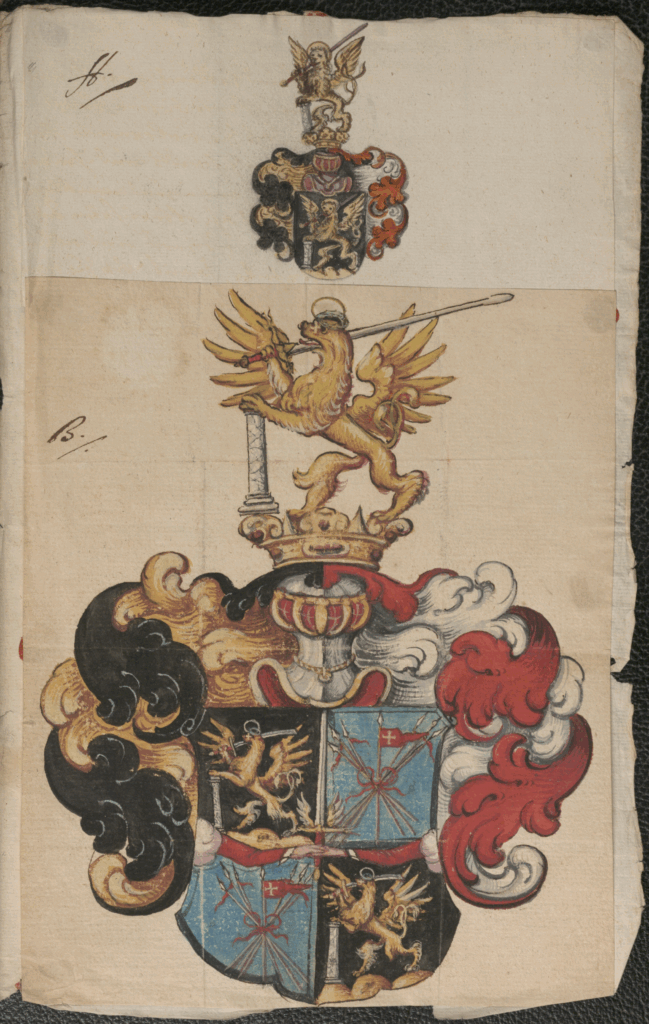
I was pleased to find my initial draft largely correct. However, the newly found source allowed me to refine the reconstruction and assess which features of the concept were ultimately adopted in the augmentation:
- Mantling
Instead of only Sable doubled Or, the mantling is composed of both Sable doubled Or and Gules doubled Argent. What seemed to be cross-hatching for Sable in copy #1 was in fact just shading. - Prominence of Gules
Gules also plays a more prominent role on the shield: the pennon and band in fields 2 and 3 are of that color, too. Moreover, all sword grips are Gules. Taken together with sleeves and mantling, this adds visual cohesion. - Central Sword
The central sword is winged Or, rather than Argent. Sidenote for sword enthusiasts: The blazon refers to it – and the sword of the lion in the crest – as “Schlachtschwert” (great sword), although in depiction it more closely resembles a long sword. That said, those are no disjunct categories and the terminology has varied over centuries and geographies. It also is of minor heraldic significance, as there is a certain latitude in how swords are represented. - Pennons, Lances, and Cross Motif
In the concept, all lances appear with pennons: the central one with a large pennon, the others with smaller ones. As the copies show only a single central pennon, I follow this reduced and thus clearer variant.
The central polearm is designated as “lange Stange” (a kind of pike) in the concept blazon and is likewise rendered in copy #1. In both the colored depiction and copy #2, however, it is indistinguishable from the other lances. I have therefore once again chosen this simpler and more readily legible form.
Furthermore, the pennon Gules is charged with a cross Or. The same motif recurs upon the lion’s forehead and, looking closely, is even visible in monochrome copy #2 – I hence added it to the reconstruction. - Lions
Somewhat redundantly, the lions are shown not only with halos, but also with laurel wreaths. This feature is absent from the copies, making it likely to be omitted in the final arms. I therefore also exclude it.
Curiously, the object beneath the lions’ left paw proves not to be a scroll, but a marble pillar. A close look at copy #2 reveals the characteristic veiny texture of the stone. While a scroll or book symbolizing the Gospel of Mark would accord with the usual iconography, both blazon and concept painting unmistakably depict the pillar.
My Reconstruction of the 1670 Augmented Marxbrüder Arms
Stylistic choices aside, I can state with high confidence that the augmented Marxbrüder arms appeared as follows.
This reconstruction rests on a solid foundation, most notably the colored concept preserved in the HHStA. Nonetheless, final confirmation must await the rediscovery of the original charter. It should be noted that the concept for an armorial charter could differ slightly from the final version. Such differences might arise between the concipist (the clerk responsible for the draft) and the heraldic painter commissioned for the final arms. Moreover, senior officials – such as the President of the Aulic Council – could order last-minute changes.
I created the reconstruction as a vector graphic, preserving every detail of the design with perfect clarity at any scale. Unlike raster images, vector graphics can be resized infinitely without loss of quality, ensuring crisp lines and vibrant colors whether displayed on a screen, printed on a banner or T-Shirt, or engraved on small items. The format also allows for easy editing, color adjustments, and reuse of individual heraldic elements in future projects or derivative works.
Should new evidence emerge – such as the rediscovery of the original charter or clarification of a specific tincture – the file’s modular structure allows for swift and precise updates. In this sense, the reconstruction is both a scholarly hypothesis and a practical tool: grounded in current evidence, open to refinement, and designed for clarity, adaptability, and reuse across digital and physical formats.
Description and Analysis of the Augmented Arms
Below follows my attempt at a full blazon of the augmentation, rendered in the traditional language of heraldry – which should by now be at least vaguely familiar to you:
- Quarterly; above the fess line, issuing from clouds on either side two arms vested Gules with cuffs Argent, clasping hands in handshake, and together holding upright a long sword with grip Gules; the sword above the guard with wings Or, turned outward.
- 1st and 4th quarters: Sable, upon a trimount Or, a Lion of St. Mark rampant Or, fork-tailed, guardant, with a cross upon his forehead, in his dexter paw an uplifted saber with grip Gules, and resting his sinister paw upon a marble pillar Argent.
- 2nd and 3rd quarters: Azure, seven crossed lances Or with heads Argent pointing upwards, the central one surmounted by a pennon Gules charged with a cross Or; all bound together in the middle with a band Gules, its ends flying downward.
- Upon the shield an open helmet crowned Or, mantled Sable doubled Or and Gules doubled Argent.
- Crest: a Lion of St. Mark rampant Or, fork-tailed, with a cross upon his forehead, in his dexter paw an uplifted long sword with grip Gules, and resting his sinister paw upon a marble pillar Argent.
This augmented coat of arms radiates Baroque bombast: the triple appearance of St. Mark’s lion – two smaller on the shield and a towering counterpart as the crest – pays homage to the guild’s patron. Beneath his left paw, the marble pillar symbolizes fortitude and constancy.
In proud display, the bundle of seven lances, crowned with a central pennon, proclaims the guild’s cohesion amid multitude, and strength through unity. The number seven is not meant in a merely numerical sense, but as an ancient symbol of harmony and completeness.
At the heart, the handshake emerging from clouds embodies fraternity, complemented by a winged sword evoking both divine sanction and referencing the guild’s principal weapon – the long sword.
Through scale, repetition, and layered symbolism, this augmentation transforms the Marxbrüder arms into a heightened proclamation of imperial favor – amplified by the aesthetic sensibilities of an age captivated by abundance as its guiding ideal.
Asset Sources and License of This Work
This coat of arms combines original elements with assets from Wikimedia Commons. The work as a whole is licensed under CC BY-SA 4.0. The attribution for components not created by me is listed in the table below.
You are free to use, modify, and share this coat of arms for any purpose, including commercially, provided that you give appropriate credit to the original authors – including me. If you distribute this design or any derivative work, you must do so under a license compatible with CC BY-SA 4.0.
| Asset | Author | License |
| Lion’s body | User: SajoR | CC BY-SA 2.5 |
| Lion’s head (crest) | User: SajoR | CC BY-SA 2.5 |
| Lion’s right paw | User: Milenioscuro | CC BY-SA 3.0 |
| Lion’s forked tail | User: MaxxL | CC BY-SA 3.0 DE |
| Saber (field 1 & 4) | User: Madboy74 | CC0 1.0 |
| Lance (field 2 & 3) | User: Zigeuner | CC BY-SA 3.0 |
| Band (field 2 & 3) | User: Celtus | CC BY-SA 3.0 |
| Cross | Ariane Schmidt | Public domain |
| Clouds | Olga Salova | PD-RU exempt |
| Hands & cuffs | User: SajoR | CC BY-SA 2.5 |
| Sleeves | User: MostEpic | CC BY-SA 4.0 |
| Sword at center | User: Madboy74 | CC BY-SA 4.0 |
| Wings of sword | User: SajoR | CC BY-SA 2.5 |
| Helmet | User: LowlyLiaison | CC BY 4.0 |
| Mantling | User: Bastianow | CC BY-SA 3.0 |
| Crown | User: Wereszcyński | CC BY-SA 4.0 |
Conclusion and Outlook
This reconstruction completes a long arc of inquiry: both the 1541 grant and the 1670 augmentation are now documented in full tincture and made publicly accessible. What began with a rediscovered charter culminates here in a validated, high-resolution rendering grounded in archival evidence.
For now, my work on the Marxbrüder arms pauses at this milestone – but I hope it serves as a foundation for future research, public engagement, and continued exploration of the Marxbrüder legacy. In my upcoming articles, we will change the setting from parchment to places – leaving the study chamber and stepping into early modern Frankfurt. We will explore where the Marxbrüder met and what traces they left in the city’s history.
Special Thanks
I would like to thank the following people who provided useful feedback on earlier iterations of this reconstruction:
- Johannes Schmidt
- Lukas Riedel
- Markus Theil
- The users of the Heraldry Discord channel – in particular Fleig, RTF, and fritzorino
Furthermore, I would like to thank Cathrin Rieger, whose suggestions enriched both the reconstruction and the article.
I am grateful to the HHStA Vienna, where a dedicated archivist guided me to the concept containing the colored arms in a convolute of Marxbrüder documents. They patiently addressed my questions, swiftly digitized the 1670 concept at my request, and granted permission for its display here.
I thank the Polytechnic Society Foundation for admitting me to the District Historian (Stadtteil-Historiker) 2025 cohort, and Oliver Ramonat for his mentoring on topic choice.
Citation Recommendation
If you’d like to reference this aricle, you might cite it as:
Theil, Kilian (2025): Baroque Bombast and Imperial Grace – Reconstructing the Marxbrüder Augmentation of 1670. Published 5 November 2025, https://kiliantheil.com/marxbruder/2025/11/05/reconstructing-marxbruder-augmentation
Appendix A: My translation of the 1670 concept for the Marxbrüder armorial augmentation (AT-OeSTA/HHStA RHR Grat Feud Conf. 48-3-1)
Created with support by GPT-5. The rest of the translation is in progress.
[…]
graciously renewed, confirmed and ratified, but such their noble coat of arms and crest also in the following manner augmented, adorned and improved, and to them and their descendants, male and female, [?] graciously permitted and granted henceforth to bear and to use forever in this way.
Namely, it is a quartered shield, whose hind lower and fore upper part or field is black, below with three yellow mountains, wherein appears forward a yellow or gold‑colored flying lion, with protruding tongue, outspread wings, double tail, on the forehead marked with a cross, crowned with a green laurel wreath, and above the head a golden halo, standing with the two hind feet upon the two rear mountains, and holding in the left forepaw beneath himself upon the third hill a white‑striped marble pillar, in the right forepaw upwards with the point, behind himself for battle, a bare saber with gilded cross and pommel.
The fore lower and hind upper quarter is sky-blue mixed with ruby color, therein crosswise six jousting lances with their points upward, three of them to the right and three to the left side, in their middle upright upon a pike [original: “lange Stange”] a tapered blood-red banner, marked with a golden cross, all bound together in the middle with a red band whose ends fly downward.
In the middle of the quartered shield appear from both sides opposite one another out of a cloud two red‑clad men’s arms with white cuffs, which hold in the middle of the shield with two joined hands a bare greatsword [original: “Schlachtschwert”] upwards with the point up to the open noble tournament helmet, with a red grip, golden cross and pommel, instead of the shield [original “Schild” a.k.a. Schilt] upon the sword on both sides with double yellow eagle’s wings, with their roots facing outward,
upon the shield a free open noble tournament helmet to the left with red and white, to the right side yellow and black mantling, and above adorned with a yellow or gold‑colored royal crown,
upon which appears the below‑described entirely yellow or gold‑colored flying lion with protruding tongue, outspread wings, double tail, on the forehead marked with a golden cross, crowned with a green laurel wreath and above the head a golden halo, standing with the hind two feet upon the crown and holding in the left forepaw beneath himself and resting on the crown a white‑striped marble pillar, in the right foreclaw upwards behind himself for battle a bare greatsword [original: “Schlachtschwert”] with gilded cross and pommel and blood‑red grip.
Thus, such augmented, adorned and improved noble coat of arms and crest in this our Imperial letter, written in booklet form, is painted on the front of the sixth leaf and duly colored.
[…]
Appendix B: My transcription of the 1670 concept for the Marxbrüder armorial augmentation (AT-OeSTA/HHStA RHR Grat Feud Conf. 48-3-1)
Created with support by Transkribus. The rest of the transcription is in progress.
[…]
genediglich eneuẅert, confirmiret und bestettiget, sondern solch ihr adeliches wappen und Cleinod auch nachfolgender massen vermehrt, geziert und verbessert, und ihnen und ihren nachkommen mannlich und weiblichen [?] geschlecht, solches hinführo eẅiglich also zu führen und zugebrauchen, genediglich erlaubt und gegönnet;
Dass mit nahmen ist ein quartierter Schildt, desßen hinder under, und vordere ober theil oder feldt schwartz, unden mit dreÿen gelben bergen, darin erscheinet fürwerths ein gelb: oder Goldtfarber fliegender Löw, mit außgeschlagener Zungen, außgebreiteten flüegeln, doppeltem schwanz, ahn der stirn mit einem Creütz bezeichnet, bekrönet mit einem grünen lorber Cranz, und oben des Kopfes einen gülden Schein herumb, stehend mit den zweÿen hindern füesßen auf den hindern Zweÿ bergen, und haltend in der linkh vordern under sich eine auff dem dritten berg stehende weiß gestreifte Marmelsteinere saüle, in der rechten vorderen auffwerths mit der spitzen, hinder sich zum streit, ein blosser Seebel mit vergüldtem Creüz und Knopff,
Vorder under und hindere ober Veldung himmelblau mit rubin farben vermischt, darinnen sechs Creüzweiß geschränckte Turnirs Lantzen mit ihren spitzen über sich, dreÿ derselben zur rechten und dreÿ zur linckhen seithen, in deren mitte steckhet auffrechts an einer langen stangen ein rother zurgespitzter bluetfahn, mit einem gülden Creütz bezeichnet, alle in der mitte mit einem rothen bandt, maschen weiß, zusammen gebunden, dessen enden abwerts fliegen,
in der mitte des quartierten Schildts erscheinen von beeden Seithen gegen einander auß einer Wolkhen zweÿ roth angethane manns Armben, mit weisßen überstulpen, die halten in der mite des Schildts, mit zweÿ zusammen geschlosßenen händen ein bloses schlachtschwerd auffwerths mit der spitzen biß ahn den offenen Adelichen Turnirs helmb, mit einem rothen schafft, guldenen Creütz und Knopff, an statt statt des Schildts an dem schwerdt an beeden seithen, mit doppelten gelben Aadlers flüegelen, deren schosßen außwerths,
auff dem Schild ein freÿer offener Adelicher Turnirshelmb zur linckh mit roth und weisser, rechter seithen gelb und schwarzer helmbdecken, und darob mit einer gelben oder goldtfarben königlich Cron geziert,
darauff erscheinet der unden im schild beschriebene ganz gelb: oder goldtfarber flüegender Löw mit außgeschlagener Zungen, außgebräiteten flüegeln, dobbeltem Schwanz, ahn der stirn mit einem gulden Creütz bezeichnet, gekrönet mit einem grüenen Lorber Crantz und oben umb den Kopff einen gelden schein, stehend mit den hindern zweÿ füsßen auff der Cron und haltend in der linkh Vordern eine under sich auf der Cron ruhende weiß gestreifte marmelsteinere Saüle, in der rechten vordern Clawen aber, auffwerts hinder sich zum streit ein blosßes schlachtschwerdt mit vergoldtem Creüz und Knopff und blueth rothem schafft;
Alß dan solch vermehrt, gezirht und verbesßertes Adeliches Wappen und Cleinod in diesem unseren, libelsweiß geschriebenen, Käÿs: Brieff dies dem sechsten blath erster seithen gemahlet und mit farben eigentlicher außgestrichen ist.
[…]
